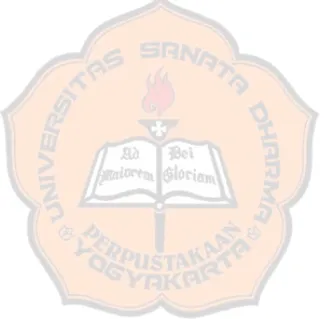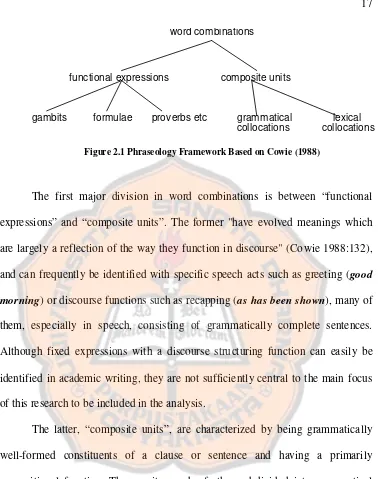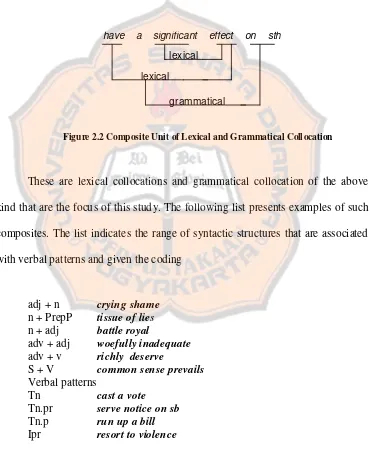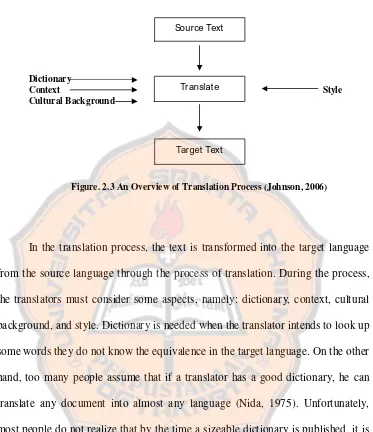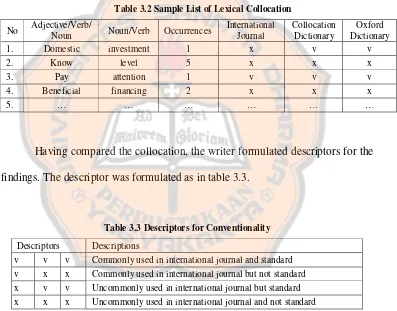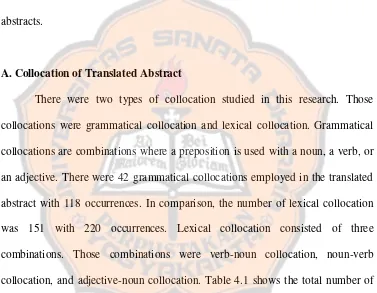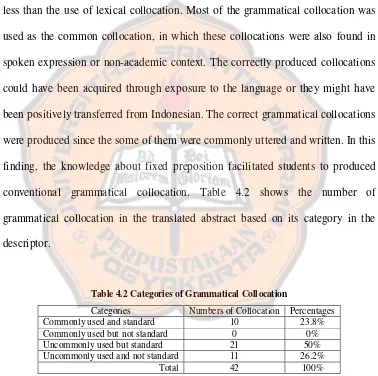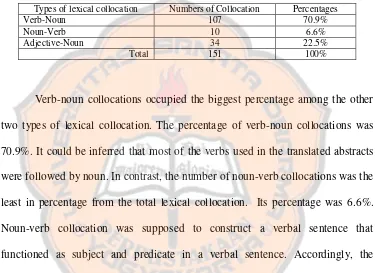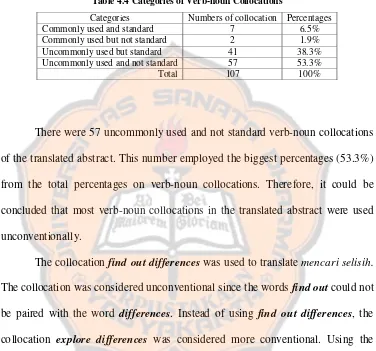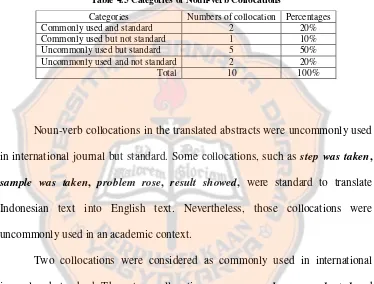vii ABSTRACT
Saputro, Andriyana Wahyu. 2009. Collocation Conventionality in the Translated Thesis Abstract of Undergraduate Students of Economic Faculty. Yogyakarta: English Language Education Study Program of Sanata Dharma University.
Collocation has become one of the characteristics of academic writing. The use of conventional collocation might become an obstacle in producing an academic writing. For a non native writer, inappropriate translation of collocation might lead to an ineffective academic text. This thesis analyzed the collocation used in the translated thesis abstract of undergraduate students of Economic Faculty of Sanata Dharma University. There were two problems formulated in this research. 1) What are the types of collocations of translated thesis abstracts of the economic faculty students? 2) To what extent does the deviation from the standard forms of conventional collocations occur in the translated thesis abstracts?
The research was a qualitative research. Document analysis was used to investigate the collocation. The research subjects were 20 thesis abstracts of undergraduate students of Economic Faculty of Sanata Dharma University. There were five instruments used to investigate the collocation conventionality. Concordance v.3.2 and Wordsmith Tools v.5 were used to find out the collocation used in the translated abstracts. Oxford Collocations Dictionary for Students of English and Oxford Advanced Learner’s Dictionary were used to determine the standard collocations. The last instrument used in this research was human instrument. The instrument was used to decide the collocations that were going to be analyzed.
The research findings revealed that there were two kinds of collocations used in the translated thesis abstracts. Those collocations were grammatical collocation and lexical collocation. The use of grammatical collocation met the standard form of English collocation. Nevertheless, most of the grammatical collocations were uncommonly used in the international academic journal. In lexical collocation, there were three types of collocations: verb-noun collocation, noun-verb collocation and, adjective-noun collocation. In contrast to the use of grammatical collocation, the use of lexical collocation was not standard and not commonly used is international journal. It was also revealed that the deviation of the standard form of collocation could be categorized into grammatical transformation, over-generalization, and blend. From the research result, it could be concluded that conventional collocation needed to be improved.
Some suggestions are addressed to lecturers and thesis sponsors, students, and other researchers. The lecturer may provide great exposure to authentic material of academic reading. The thesis sponsor should supervise the abstract more intensely and provide valuable feedback to the abstract to maintain academic style. The students should expose themselves with more English academic reading passage.
viii ABSTRAK
Saputro, Andriyana Wahyu. 2009. Collocation Conventionality in the Translated Thesis Abstract of Undergraduate Students of Economic Faculty. Yogyakarta: Program Studi Pendidikan Bahasa Inggris Universitas Sanata Dharma.
Kolokasi merupakan salah satu satu karakteristik penulisan karya ilmiah. Penggunaan kolokasi dapat menjadi hambatan dalam penulisan karya ilmiah. Terjemahan kolokasi yang tidak tepat menghasilkan karya ilmiah yang tidak efektif. Skripsi ini menganalisa penggunaan kolokasi dalam abstrak terjemahan dari skripsi mahasiswa Fakultas Ekonomi Universitas Sanata Dharma. Ada dua rumusan masalah yang diajukan dalam skripsi ini. 1) Apa saja kolokasi yang terdapat dalam abstrak terjemahan dari skripsi mahasiswa fakultas ekonomi? 2) Sejauh mana penyimpangan dari kolokasi yang konvensional terjadi dalam abstrak terjemahan tersebut?
Metode yang digunakan dalam skripsi ini adalah penelitian kualitatif. Analisa dokumen digunakan untuk meneliti kolokasi dalam abstrak terjemahan. Dokumen yang dipelajari adalah 20 abstrak terjemahan dari mahasiswa Fakultas Ekonomi Universitas Sanata Dharma. Ada lima instrumen yang digunakan untuk meneliti konvensionalitas kolokasi. Concordance v.3.2 and Wordsmith Tools v.5
digunakan untuk melihat kolokasi yang terdapat dalam abstrak terjemahan. Oxford
Collocations Dictionary for Students of English and Oxford Advanced Learner s Dictionarydigunakan untuk menentukan kolokasi yang standar. Instrumen manusia juga digunakan untuk menentukan kolokasi yang akan dianalisa
Hasil penelitian menunjukkan bahwa terdapat dua jenis kolokasi yang terdapat dalam abstrak terjemahan, yaitu kolokasi leksikal dan kolokasi gramatikal. Penggunaan kolokasi gramatikal sesuai dengan bentuk standar kolokasi bahasa Inggris. Meskipun demikian, sebagian kolokasi yang digunakan merupakan kolokasi yang tidak lazim digunakan dalam jurnal akademik internasional. Hasil penelitian juga menunjukkan bahwa terdapat tiga jenis kolokasi lexical, yaitu kolokasi kata kerja-kata benda, kolokasi kata benda-katakerja, dan kolokasi kata sifat-kata benda. Penggunaan kolokasi lexical dalam abstrak terjemahan tidak sesuai standar dan tida lazim digunakan dalam jurnal akademis internasional. Dalam penelitian ini juga ditemukan bahwa ada penyimpangan bentuk standar kolokasi dapat dikategorikan menjadi tiga, yaitu grammatical transformation, overgeneralization, dan blend. Dari hasil penelitian, dapat disimpulkan bahwa penggunaan kolokasi yang konvensional dalam karya ilmiah perlu ditingkatkan.
Beberapa saran ditujukan kepada para dosen dan pembimbing skripsi, mahasiswa, dan peneliti lainnya. Para dosen hendaknya memberikan materi bacaan akademik yang autentik. Pembimbing skripsi hendaknya memperhatikan abstrak dengan lebih teliti dan menyediakan umpan balik untuk menjaga gaya penulisan akademik. Para mahasiswa hendaknya meningkatkan kemampuan mereka dengan membaca text yang bersifat akademik dalam bahasa Inggris.
COLLOCATION CONVENTIONALITY IN THE TRANSLATED THESIS ABSTRACTS
OF THE UNDERGRADUATE STUDENTS OF THE ECONOMICS FACULTY
A THESIS
Presented as Partial Fulfillment of the Requirements to Obtain theSarjana PendidikanDegree
in English Language Education
By
Andriyana Wahyu Saputro Student Number: 031214151
ENGLISH LANGUAGE EDUCATION STUDY PROGRAM DEPARTMENT OF LANGUAGE AND ARTS EDUCATION FACULTY OF TEACHERS TRAINING AND EDUCATION
SANATA DHARMA UNIVERSITY YOGYAKARTA
i
COLLOCATION CONVENTIONALITY IN THE TRANSLATED THESIS ABSTRACTS
OF THE UNDERGRADUATE STUDENTS OF THE ECONOMICS FACULTY
A THESIS
Presented as Partial Fulfillment of the Requirements to Obtain theSarjana PendidikanDegree
in English Language Education
By
Andriyana Wahyu Saputro Student Number: 031214151
ENGLISH LANGUAGE EDUCATION STUDY PROGRAM DEPARTMENT OF LANGUAGE AND ARTS EDUCATION FACULTY OF TEACHERS TRAINING AND EDUCATION
SANATA DHARMA UNIVERSITY YOGYAKARTA
iv
v
STATEMENT OF WORK’S ORIGINALITY
I honestly declare that this thesis, which I have written, does not contain the work or parts of the work of other people, except those cited in the quotations and the references, as a scientific paper should.
Yogyakarta, 22 June 2009 The Writer
vi
LEMBAR PERNYATAAN PERSETUJUAN
PUBLIKASI KARYA ILMIAH UNTUK KEPENTINGAN AKADEMIS
Yang bertanda tangan di bawah ini, saya mahasiswa Universitas Sanata Dharma: Nama : Andriyana Wahyu Saputro
Nomor Mahasiswa : 031214151
Demi pengembangan ilmu pengetahuan, saya memberikan kepada Perpustakaan Universitas Sanata Dharma karya ilmiah saya yang berjudul:
COLLOCATION CONVENTIONALITY IN THE TRANSLATED THESIS ABSTRACTS OF THE UNDERGRADUATE STUDENTS OF THE ECONOMICS FACULTY
Dengan demikian, saya memberikan kepada Perpustakaan Universitas Sanata Dharma hak untuk menyimpan,mengalihkan dalam bentuk media lain, mengelolanya dalam bentuk pangkalan data, mendistribusikan secara terbatas dan mempublikasikannya di internet atau media lain untuk kepentingan akademis tanpa perlu meminta ijin dari saya maupun memberikan royalti kepada saya selama tetap mencantumkan nama saya sebagai penulis.
Demikian pernyataan ini saya buat dengan sebenarnya. Dibuat di Yogyakarta
Pada tanggal: 22 Juni 2009
Yang menyatakan
vii ABSTRACT
Saputro, Andriyana Wahyu. 2009. Collocation Conventionality in the Translated Thesis Abstract of Undergraduate Students of Economic Faculty. Yogyakarta: English Language Education Study Program of Sanata Dharma University.
Collocation has become one of the characteristics of academic writing. The use of conventional collocation might become an obstacle in producing an academic writing. For a non native writer, inappropriate translation of collocation might lead to an ineffective academic text. This thesis analyzed the collocation used in the translated thesis abstract of undergraduate students of Economic Faculty of Sanata Dharma University. There were two problems formulated in this research. 1) What are the types of collocations of translated thesis abstracts of the economic faculty students? 2) To what extent does the deviation from the standard forms of conventional collocations occur in the translated thesis abstracts?
The research was a qualitative research. Document analysis was used to investigate the collocation. The research subjects were 20 thesis abstracts of undergraduate students of Economic Faculty of Sanata Dharma University. There were five instruments used to investigate the collocation conventionality. Concordance v.3.2 and Wordsmith Tools v.5 were used to find out the collocation used in the translated abstracts. Oxford Collocations Dictionary for Students of English and Oxford Advanced Learner’s Dictionary were used to determine the standard collocations. The last instrument used in this research was human instrument. The instrument was used to decide the collocations that were going to be analyzed.
The research findings revealed that there were two kinds of collocations used in the translated thesis abstracts. Those collocations were grammatical collocation and lexical collocation. The use of grammatical collocation met the standard form of English collocation. Nevertheless, most of the grammatical collocations were uncommonly used in the international academic journal. In lexical collocation, there were three types of collocations: verb-noun collocation, noun-verb collocation and, adjective-noun collocation. In contrast to the use of grammatical collocation, the use of lexical collocation was not standard and not commonly used is international journal. It was also revealed that the deviation of the standard form of collocation could be categorized into grammatical transformation, over-generalization, and blend. From the research result, it could be concluded that conventional collocation needed to be improved.
Some suggestions are addressed to lecturers and thesis sponsors, students, and other researchers. The lecturer may provide great exposure to authentic material of academic reading. The thesis sponsor should supervise the abstract more intensely and provide valuable feedback to the abstract to maintain academic style. The students should expose themselves with more English academic reading passage.
viii ABSTRAK
Saputro, Andriyana Wahyu. 2009. Collocation Conventionality in the Translated Thesis Abstract of Undergraduate Students of Economic Faculty. Yogyakarta: Program Studi Pendidikan Bahasa Inggris Universitas Sanata Dharma.
Kolokasi merupakan salah satu satu karakteristik penulisan karya ilmiah. Penggunaan kolokasi dapat menjadi hambatan dalam penulisan karya ilmiah. Terjemahan kolokasi yang tidak tepat menghasilkan karya ilmiah yang tidak efektif. Skripsi ini menganalisa penggunaan kolokasi dalam abstrak terjemahan dari skripsi mahasiswa Fakultas Ekonomi Universitas Sanata Dharma. Ada dua rumusan masalah yang diajukan dalam skripsi ini. 1) Apa saja kolokasi yang terdapat dalam abstrak terjemahan dari skripsi mahasiswa fakultas ekonomi? 2) Sejauh mana penyimpangan dari kolokasi yang konvensional terjadi dalam abstrak terjemahan tersebut?
Metode yang digunakan dalam skripsi ini adalah penelitian kualitatif. Analisa dokumen digunakan untuk meneliti kolokasi dalam abstrak terjemahan. Dokumen yang dipelajari adalah 20 abstrak terjemahan dari mahasiswa Fakultas Ekonomi Universitas Sanata Dharma. Ada lima instrumen yang digunakan untuk meneliti konvensionalitas kolokasi. Concordance v.3.2 and Wordsmith Tools v.5
digunakan untuk melihat kolokasi yang terdapat dalam abstrak terjemahan. Oxford
Collocations Dictionary for Students of English and Oxford Advanced Learner s Dictionarydigunakan untuk menentukan kolokasi yang standar. Instrumen manusia juga digunakan untuk menentukan kolokasi yang akan dianalisa
Hasil penelitian menunjukkan bahwa terdapat dua jenis kolokasi yang terdapat dalam abstrak terjemahan, yaitu kolokasi leksikal dan kolokasi gramatikal. Penggunaan kolokasi gramatikal sesuai dengan bentuk standar kolokasi bahasa Inggris. Meskipun demikian, sebagian kolokasi yang digunakan merupakan kolokasi yang tidak lazim digunakan dalam jurnal akademik internasional. Hasil penelitian juga menunjukkan bahwa terdapat tiga jenis kolokasi lexical, yaitu kolokasi kata kerja-kata benda, kolokasi kata benda-katakerja, dan kolokasi kata sifat-kata benda. Penggunaan kolokasi lexical dalam abstrak terjemahan tidak sesuai standar dan tida lazim digunakan dalam jurnal akademis internasional. Dalam penelitian ini juga ditemukan bahwa ada penyimpangan bentuk standar kolokasi dapat dikategorikan menjadi tiga, yaitu grammatical transformation, overgeneralization, dan blend. Dari hasil penelitian, dapat disimpulkan bahwa penggunaan kolokasi yang konvensional dalam karya ilmiah perlu ditingkatkan.
Beberapa saran ditujukan kepada para dosen dan pembimbing skripsi, mahasiswa, dan peneliti lainnya. Para dosen hendaknya memberikan materi bacaan akademik yang autentik. Pembimbing skripsi hendaknya memperhatikan abstrak dengan lebih teliti dan menyediakan umpan balik untuk menjaga gaya penulisan akademik. Para mahasiswa hendaknya meningkatkan kemampuan mereka dengan membaca text yang bersifat akademik dalam bahasa Inggris.
ix
ACKNOWLEDGEMENTS
First of all, I would like to give my praise and greatest gratitude to Jesus Christ for His blessing, grace, love, and guidance both in my ups and my downs during my study and thesis completion. My gratefulness is worth giving to Mother Mary, to whom I go whenever I face problems.
I am greatly indebted to FX. Ouda Teda Ena, S.Pd., M.Pd. my sponsor, for giving me attention, suggestions, guidance, and motivation during the completion of my thesis. My sincere gratitude also goes to all lecturers of English Education Study Program, who have given me so many valuable things during my study. I owe a debt of gratitude to Laurentia Sumarni, S.Pd. for kindly proofreading and providing valuable feedback on my thesis. I also indebted to Dewi Widyastuti, S.Pd., M.Hum. for helping me to get the collocation dictionary.
x
I also would like to thank the Language Institute of Sanata Dharma University for giving me great responsibilities and opportunities to learn and apply my knowledge in English teaching. My gratitude goes to my colleagues in the Language Institute of Sanata Dharma University: Dr. Retno Muljani, M.Pd., tante
Di, Dian, Tika, Ucan, Yere, mas Sandi and all colleagues that I cannot mention personally. Their willingness and support encourage me so much to complete my thesis.
xi
TABLE OF CONTENTS
Page
TITLE PAGE ... i
APPROVAL PAGES ... ii
PAGE OF DEDICATION………..………. iv
STATEMENT OF WORK’S ORIGINALITY ... v
LEMBAR PERNYATAAN PERSETUJUAN PUBLIKASI………. .. vi
ABSTRACT ... vii
ABSTRAK ... viii
ACKNOWLEDGEMENTS ... ix
TABLE OF CONTENTS ... xi
LIST OF TABLES ... xiv
LIST OF FIGURES ... xv
LIST OF APPENDICES ... xvi
CHAPTER I. INTRODUCTION A. Research Background... 1
B. Problem Formulation ... 5
C. Problem Limitation ... 5
D. Research Objectives ... 6
E. Research Benefits... 7
xii
CHAPTER II. REVIEW OF RELATED LITERATURE
A. Theoretical Description ... 11
1. Collocation ... 11
a. Definition of Collocation ... 11
b. Criteria of Collocation ... 12
1) Non-compositionality………... 12
2) Non-substitutability……….…… 12
3) Non-modifiability……….…….... 13
2. Phraseology Framework ... 16
3. Translation ... 19
a. Definition of Translation ... 19
b. First and Second Language Translation ... 21
c. Translating First Language Essay into Second Language Essay ... 23
d. Translation Method ... 24
e. Translation Process ... 26
B. Theoretical Framework ... 28
CHAPTER III. METHODOLOGY A. Research Method ... 32
B. Research Subject Studied ... 33
C. Research Instruments ... 34
xiii
E. Data Analysis Technique... 36
F. Research Procedure ... 38
CHAPTER IV. RESEARCH FINDINGS AND DISCUSSIONS A. Collocation of Translated Abstract ... 39
1. Grammatical Collocation ... 40
2. Lexical Collocation ... 42
a. Verb-noun Collocation ... 42
b. Noun-verb Collocation ... 44
c. Adjective-noun Collocation ... 46
B. Deviation of Conventional Collocation ... 47
1. Deviation on Grammatical Collocation ... 49
2. Deviation on Lexical Collocation ... 52
a. Grammatical Transformation ... 52
b. Over-Generalization ... 53
c. Blend ... 53
CHAPTER V. CONCLUSIONS AND SUGGESTIONS A. Conclusions ... 55
B. Suggestions ... 57
REFERENCES ... 59
xiv
LIST OF TABLES
Table 3.1 Sample List of Grammatical Collocation ... 37
Table 3.2 Sample List of Lexical Collocation ... 37
Table 3.3 Descriptors for Conventionality ... 37
Table 4.1 Number and Percentage of Collocation ... 39
Table 4.2 Categories of Grammatical Collocation ... 40
Table 4.3 Number and Percentages of Lexical Collocations ... 42
Table 4.4 Categories of Verb-noun Collocations ... 43
Table 4.5 Categories of Noun-verb Collocations ... 45
Table 4.6 Categories of Adjective-noun Collocations ... 46
Table 4.7 Comparison of Number and Percentages between Grammatical and Lexical Collocation Based Categories ... 48
Table 4.8 List of Unconventional Grammatical Collocations ... 49
Table 4.9 List of Unconventional Lexical Collocations due to Over-generalization ... 53
xv
LIST OF FIGURES
xvi
LIST OF APPENDICES
Appendix A List of Grammatical Collocations ... 62
Appendix B List of Verb-Noun Collocations... 64
Appendix C List of Noun-Verb Collocations... 68
Appendix D List of Adjective-Noun Collocations ... 69
1 CHAPTER I INTRODUCTION
In this chapter, the researcher reviews the research background, problem formulation, problem limitation, research objectives, research benefits, and definition of terms.
A. Research Background
English has been the lingua franca for science literature (Navarro, 2001). The statement proposed by Navarro is based on a recent trend in Western world since the 1950s. Of all the scientific genres, research articles are the most important and prestigious communicative tool of the discourse community for scientific experts (Swales, 1990; Rodriguez, 2000). Research articles in science have been the subject of much investigation (e.g. Bazerman, 1988; Myers, 1989; Butler, 1990; Hunston, 1994). From the numbers of investigation, it is considered essential for every scientific expert who wants to be part of his/her discourse community to be able to write adequate research articles. Because of the importance of research articles and of English as the main language of the international science community, many scientists whose native language is not English prefer to publish their research results in English in international scientific journal.
common readers or academic community. In the future, it is expected that research results can be published internationally. Therefore, English is one of the requirements for a research result to be internationally read. In short, ability to write in English has always been held in high esteem in Indonesian education program, particularly in university level. While writing directly in English has been considered as a complex activity, translation has become an alternative to reflect writer’s communicative skills (Shokrpour & Fallahzadeh, 2007).
The abstract in universities in Indonesia is required to be written in two languages. Those are Indonesian and English (hereafter, Source Text (ST) and Target Text (TT)). Based on the preliminary survey conducted to twenty graduate students of the Economics Faculty of Sanata Dharma University, all of the respondents stated that they constructed their abstract in the first language and then translated it in the second language.
The demand to publish research paper in English has required students to have sufficient knowledge and skill in English. In Indonesian setting, since English is considered as a foreign language, it is assumed that not all students have sufficient knowledge and skill in English. It is implied that writing the whole research paper in English seems to be impossible for non English learners. Therefore, the requirement is simplified. It is now required that the abstract must be written in English. Nevertheless, students do not write abstract directly in English. They make use of translation in producing English abstract.
of certain conceptual domains. Problems might occur in the translation process. One of the problems is verb usage. Since there is no exact equivalence between ST and TT, there are always possibilities that a word in ST could be translated into some other words in TT. In this situation, students use wrong words in the translation. Diction becomes one of the problems that students will face.
While facing problems arising in translation, another problem hinders the students to produce an effective and conventional text. The problem mentioned here is the problem in the translation of some verbs and phrases which lexicalize universal conceptual domains. The word “conventional” itself is vague. Nevertheless, Howarth (1998) defined “conventional” in two complementary senses, to mean: firstly, the degree to which writers of academic English use familiar, prefabricated word combinations (which in this research are limited to certain types of collocation); and secondly, the extent to which those combinations are used in their standard forms.
frequently not well developed, hampering the easy comprehension of and reducing the effectiveness of their translation (Howarth, 1998).
Two different collocations might have similar constructions. Nevertheless, they are unpredictable for non-native speakers and usually do not have a literal translation. Consider, for instance, the collocation to beat the record. This collocation is used to translate Indonesian collocationmemecahkan rekor.A non-native speaker of English would literally choosebreak as the support verb for the noun record. In fact, this collocation could not be translated in a word-for-word fashion into English asto break a record, but asto beat a record.
While students are able to find the most equivalent words, they might face the problem of finding the correct collocation. Recent corpus-based studies (Biber
et al. 1999; Oakey 2002; Biber 2004; Biber et al. 2004) have pointed to the existence of an EAP phraseology characterized by word combinations that fulfil organizational and rhetorical functions that are prominent in academic writing, such as it has been suggested, it should be noted that, as shown in figure, for example, as a result of, and in the presence of. Howarth (1998) claimed that learners need lexical means that will allow them to conform to the native stylistic norms for a particular register, which entails not only making appropriate grammatical and lexical choices but also selecting conventional multi-word units to an appropriate extent for effective communication in academic settings.
Faculty of Sanata Dharma University. The subject studied is a research result that is represented by abstract. Tippet (2007) stated that an abstract is condensed version of a longer piece of writing that highlights the major points covered. It concisely describes the content and scope of the writing, and reviews the writing’s contents in abbreviated form. Writing an excellent abstract is vital to encourage readers to obtain the full paper, read it, and cite it. With the phenomenon of information overload, many researchers will read only the abstract of a paper. With the advent of abstract databases, many readers will see an abstract separately from the rest of the paper.
B. Problem Formulation
There are two major questions that appear in this research, namely:
1. What are the types of collocations of the translated thesis abstracts of the Economics faculty students?
2. To what extent does the deviation from the standard forms of conventional collocations occur in the translated thesis abstracts?
C. Problem Limitation
the research investigates possibilities of diction on verbs translation from Indonesian to English.
The research discussed the abstract produced by the economics students, particularly accounting study program. The chosen thesis abstracts were those which had been submitted to the Library of Sanata Dharma University and had been the input in the library thesis data base in September 2007. The abstracts were those that were first written in the ST (Indonesia) and translated into the TT (English). The translated abstracts were chosen regardless who the translators are. In other words, the choosing of abstract products disregarded the fact whether the students translated the abstract by themselves or using professional translators.
D. Research Objectives
E. Research Benefits
The study will be useful for the people who are concerned with language teaching and learning, particularly in translation. The result of this study can recommend alternative approach in translation. This study may call attention to the ways how students use their source language when preparing and translating an abstract into target language. Results from this study would support the notion that using source language benefits for some students in certain translation tasks, and therefore the study seems to lend some support to the value of coaching materials dealing with translation strategies, especially in lexicon level.
This study benefits learners in choosing the right diction in translating collocation into the target language. By translating collocation appropriately, the students can also maintain the characteristics of academic writing. The study will also benefit the future researchers. This is because there are possibilities that question will arise after the results of this study are presented. This question can be the basis to conduct further more specific research.
F. Definition of Terms
There are terms used in this study. The writer will give the explanation of each term in order to avoid misinterpretation. Those terms are collocation, conventionality, translation, abstract, translated abstract, undergraduate
1. Collocation
Firth (1957: 181) defined collocation as a statement of the habitual or customary places of word. In the other words, it is a combination of adjacent words which frequently occur together. There are two kinds of collocation, among others, that are studied in this research. Those are grammatical collocation and lexical collocation.
2. Conventionality
Conventionality is defined as the degree to which writers of academic English use familiar and prefabricated word combinations. The second definition about conventionality is the extent to which those combinations are used in their standard forms. In this research, conventionality is perceived as whether or not the collocation is commonly used the international journal and exists in their standard form in the dictionaries
3. Abstract
students of the Economics Faculty that have been submitted to the university library during September 2007.
4. Translated Abstract
Translated writing is an approach of putting ideas in the first language (L1) and then translating it in the second language (L2). The first language in the context of this paper is Indonesian. One of the processes involved in this kind of writing is translation process. The students engaging in this writing would put their ideas in L1 and then translate in L2. In the context of undergraduate students of the economics Faculty, an abstract is written in Indonesia and then translated into English.
5. Undergraduate Students
The students that produced the abstracts are the undergraduate students of the Economics Faculty that have finished conducting the research and writing the abstracts. They submitted the full version of their theses to the Library of Sanata Dharma University on August 2007. The students have graduated in the academic year 2007 and obtained aSarjana Ekonomidegree.
6. The Economics Faculty
11 CHAPTER II
REVIEW OF RELATED LITERATURE
Some theories are considered to be the bases of this research. In this chapter, the researcher reviews those basic theories and then gives the theoretical framework of this thesis. This chapter is divided into two main parts; those are theoretical description and theoretical framework. Some sources are cited on the text.
A. Theoretical Description
There are four major issues underlying this research. Those are the issues on collocation, phraseology framework, and translation. Each issue is reviewed in terms of the theories and previous research findings of the issues mentioned. 1. Collocation
a. Definition of Collocation
can cluster with a wide range of other words whereas in restricted collocations, they are fixed (Al- Salmani, 2001; Emery, 1991).
Some authors in the computational and statistical literature define a collocation as two or more “consecutive” words with a special behavior. Choueka (1988) defines collocation as a sequence of two or more consecutive words, that has characteristics of a syntactic and semantic unit, and whose exact and unambiguous meaning or connotation cannot be derived directly from the meaning or connotation of its components.
b. Criteria of Collocation
The following criteria are typical of linguistic treatments of collocations (see for example Benson (1989) and Brundage et al. (1992)).
1). Non-compositionality
The meaning of a collocation is not a straightforward composition of the meanings of its parts. Either the meaning is completely different from the free combination (as in the case of idioms like kick the bucket) or there is a connotation or added element of meaning that cannot be predicted from the parts. For example, white wine, white hair and white woman all refer to slightly different colors, so a writer can regard them as collocations.
2). Non-substitutability
wine even though yellow is as good description of the color of white wine as whiteis (it is kind of a yellowish white).
3). Non-modifiability
Many collocations cannot be freely modified with additional lexical material or through grammatical transformations. This is especially true for frozen expressions like idioms. For example, we can’t modifyfrog in to get a frog in one s throat into to get an ugly frog in one s throat although usually nouns like frog can be modified by adjectives like ugly. Similarly, going from singular to plural can make an idiom ill-formed, for example in people as poor as church mice.
A moderate way to test whether a combination is a collocation is to translate it into another language. If we cannot translate the combination word by word, then that is evidence that we are dealing with a collocation. For example, translating make a decision into Indonesian, a writer would get membuat keputusanwhich is correct. In English a writer cannot write create a decision to translate membuat keputusan. So that is evidence that make a decision is a collocation in English.
order and use the terms “association” and “co-occurrence” for the more general phenomenon of words that are likely to be used in the same context.
The concept of collocation can be perceived through some subclasses of collocations. Verbs with little semantic content likemake, takeand doare called light verbs in collocations like make a decision or do a favor. There is hardly anything about the meaning of make,takeordothat would explain why we have to saymake a decision instead oftake a decisionanddo a favorinstead ofmake a favor, but for many computational purposes the correct light verb for combination with a particular noun must be determined and thus acquired from corpora if this information is not available in machine-readable dictionaries.
Dras and Johnson (1996) examine one approach to English lexicon. Verb particle constructions or phrasal verbs are an especially important part of the lexicon of English. Many verbs in English liketo tell offand to go down consist of a combination of a main verb and a particle. This type of construction is a good example of a collocation with often non-adjacent words. Proper nouns (also called proper names) are usually included in the category of collocations in computational work although they are quite different from lexical collocations. They are most agreeable to approaches that look for fixed phrases that reappear in exactly the same form throughout a text.
make sure that all instances ofhydraulic oil filterare translated by the same term. If two different translations are used (even if they have the same meaning in some sense), the reader of the translated manual would get confused and think that two different entities are being described.
Respectively, word combinations are also classified as grammatical and lexical collocations (Al- Salmani, 2001; Emery, 1991). Grammatical collocations are combinations where a preposition is used with a noun, a verb, or an adjective, (for example: by accident, admiration for, agree with, account for, afraid of, amazed at). Lexical collocations include: verb+noun (e.g. break a code, lift a blockade); verb+adverb (e.g.affect deeply, appreciate sincerely); noun+verb (e.g. water freezes, clock ticks); adjective+noun (e.g. strong tea, best wishes); adverb+adjective (e.g.deeply absorbed, closely related)
Acquisition and correct production of such word combinations is a mark of an advanced level of proficiency in a language. As Lewis (1997, p.15) puts it “fluency is based on the acquisition of a large store of fixed or semi-fixed prefabricated items.” James (1998, p.152) also agrees that the correct usage of collocations “contributes greatly to one’s idiomaticity and nativelikeness.” Taiwo (2004) sees lexical errors and grammatical errors as equally important. Sonaiya (1988) goes even further to say that lexical errors are more serious because effective communication depends on the choice of words.
Meaning emphasizes the importance of context: the context of the social setting, the context of spoken and textual discourse, and, important for collocations, the context of surrounding words. These contextual features easily get lost in the abstract treatment that is typical of structural linguistics.
A good example of the type of problem that is seen as important in this contextual view of language is Halliday’s example of strong vs. powerful tea (Halliday 1966: 150). It is a convention in English to talk about strong tea, not powerful tea, although any speaker of English would also understand the latter unconventional expression. Arguably, there are no interesting structural properties of English that can be collected from this contrast. However, the contrast may tell the readers something interesting about attitudes towards different types of substances in readers’ culture (why do we usepowerfulfor drugs like heroin, but not for cigarettes, tea and coffee?) and it is obviously important to teach this contrast to students who want to learn idiomatically correct English. Most collocations are also assumed adjacency of words. But in most linguistically oriented research, a phrase can be a collocation even if it is not consecutive (as in the exampleprovide information).
2. Phraseology Framework
word combinations
functional expressions composite units
gambits formulae proverbs etc grammatical lexical collocations collocations
Figure 2.1 Phraseology Framework Based on Cowie (1988)
The first major division in word combinations is between “functional expressions” and “composite units”. The former "have evolved meanings which are largely a reflection of the way they function in discourse" (Cowie 1988:132), and can frequently be identified with specific speech acts such as greeting (good morning) or discourse functions such as recapping (as has been shown), many of them, especially in speech, consisting of grammatically complete sentences. Although fixed expressions with a discourse structuring function can easily be identified in academic writing, they are not sufficiently central to the main focus of this research to be included in the analysis.
intervene between the two primary elements in the collocation and form a compulsory constituent: for example:have a significant effect on someone. This combination is a recognisable unit as a whole and at the same time is composed of both grammatical and lexical collocations. Figure 2.2 shows an example of composite unit of lexical and grammatical collocation.
have a significant effect on sth
lexical
grammatical lexical
Figure 2.2 Composite Unit of Lexical and Grammatical Collocation
These are lexical collocations and grammatical collocation of the above kind that are the focus of this study. The following list presents examples of such composites. The list indicates the range of syntactic structures that are associated with verbal patterns and given the coding
adj + n crying shame n + PrepP tissue of lies
n + adj battle royal
adv + adj woefully inadequate adv + v richly deserve
S + V common sense prevails Verbal patterns
Tn cast a vote
Tn.pr serve notice on sb
Tn.p run up a bill
It is essential to consider lexical collocations as realisations of specific syntactic patterns, rather than as mere co-occurrences of word forms on the surface of texts. The psycholinguistic evidence points to word combinations being stored and retrieved in combination with their syntactic structures (Pawley & Syder 1983: 209). They are to varying degrees manipulated as wholes, or 'lexicalised' (Pawley, 1985). The more lexicalised they are the less language users analyse them into their constituent parts and the more speedily they can be retrieved and comprehended (Gibbs & Gonzales, 1985). The most extreme instances of this phenomenon are idiomatic expressions which are semantically unanalyzable (e.g. kick the bucket) and occasionally syntactically inconsistent (trip the light fantastic). In addition, there are numerous idiosyncratic structural features of lexical combinations. Compare, for example, the idiom take steps to do something, which cannot be used in that sense with a singular noun and is frequently found in the passive form, with take a step/two steps forward, as a figurative idiom and take a step/several steps towards somebody, a restricted collocation, which can be used with either a singular or plural noun and would be unusual in the passive. Indeed the co-occurrence of step and take in a passive construction would strongly bias the interpretation towards the idiomatic sense.
3. Translation
a. Definition of Translation
Bell (1991) defined translation as the expression in another language (or target language) of what has been expressed in another, source language, preserving semantic and stylistic equivalences. Through this definition, Dubois perceived the notion of movement of some sort between languages, content of some kind and the obligation to find equivalent which preserve features of the original.
The idea of equivalence is also supported by Meetham and Hudson (1972), as cited by Bell (1991). They stated that translation is the replacement of representation of a text in one language by representation of an equivalent text in a second language. Texts in different languages can be equivalent in different degrees (fully of partially equivalent), in respect of different levels of presentation (equivalent in respect of context, of semantics, of grammar, of lexis, etc.), and at different ranks (word-for-word, phrase-for phrase, sentence-for-sentence) (Meetham and Hudson, 1972).
Languages are different from each other. They are different in form having codes and rules regulating the construction of grammatical stretches of language and these forms have different meanings. It implies that in translation; something might be lost (or even, gained).
Another definition of translation is proposed by Newmark (1981). He stated that
From this definition, some points concerning translation can be highlighted. Those three points are: (a) replacement of written message, (b) some kind of loss meaning, and a continuous tension. In other words, translation is an act to replace written massage in one language into another language in which a translator might experience tension when doing translation. During this process, there might be a loss of meaning in the form of increasing detail, i.e. overtranslation and/or increasing generalization, i.e. undertranslation.
Nida and Taber (1969), as cited by Suryawinata (1989) stated that translating consists of reproducing message in the receptor language, the closest natural equivalent of the source-language message, first in terms of meaning and secondly in terms of style. The definition proposed by Nida and Taber brings an implication that translation has four important ideas. Those ideas cover reproducing message, natural equivalence, meaning, and style
b. First and Second Language Translation
language. Campbell (1998), inTranslation into the Second Language, p.57, wrote that
…native writer can manipulate all the devices that go to make up natural-looking text. The same case could be argued at finer levels of linguistic analysis; first language writers are, presumably, less likely to make grammatical errors and unfortunate vocabulary choices than second language writers.
Yet translation will often be required into the second language, where despite advantages of probably better comprehension of the first language source text there is the difficulty of composition into the second language.
Structure within language, however complex it is, seems to cause little difficulty for native speakers. However it may often be difficult for foreigners to replicate or master that structure. This implies difficulty in translating from the structure of one language to another. The question of the use ifdi- versusme- in verbs formation, with associated fine distinctions of meaning, has been set out well by Bambang Kaswanti Purwo (1989), and the translator will understand the use of this form. In translation, however, it is important not to be restricted by invariably translating di- with an English passive. It is important to convey the emphasis in an Indonesian sentence appropriately in English, and an active-passive distinction may be inadequate to convey what the Indonesian conveys (Johnson, 2006).
is not true. It is certainly true that a translation into the translator’s mother tongue will appeal more to audience. It can be immediately comprehensible and of course quite grammatically correct and natural. The catch is of course that audience will not be able to judge how the translation compares with the original.
On the other hand, a translation out of the translator’s native language will not likely misinterpret the original, but it may well alienate the sympathies of audience, who may feel that the translation is clumsy, incomprehensible in places, and inappropriate in diction. The audience would rather have the translation done by their own translator (Johnson, 2006).
c. Translating First Language Essay into Second Language Essay
Translation is an activity comprising the interpretation of the meaning of a text in one language - the source text - and the production, in another language, of a new, equivalent text - the target text, or translation. Traditionally, translation has been a human activity, although attempts have been made to automate and computerize the translation of natural-language texts (machine translation) or to use computers as an aid to translation (computer-assisted translation).
Campbell (1998) assumes that translation competence into the second language is somehow scrambled up with second language proficiency. It is however a very special variety of second language proficiency: the second language translators have to work within the limitations of their second language repertoire, and the stages of individuals’ language development must be reflected in the quality of their translation. Yet, the translators also have to work within the limitation of the source text, and it is this that makes translation into second language a very special variety of second language writing (Campbell, 1998).
One of the aspects of translating a first language essay into a second language essay is in the special character of written language itself (Campbell, 1998). There is the fact that high levels of second language proficiency in writing reflect control over special features of written language. Chafe and Tannen (1987) review the literature on the differences between written and spoken language. The first part of the review deals with the structural differences between the two modes, while the second treats the contextual influences on their use and creation.
d. Translation Method
Vinay and Darbelnet (2004) describe seven translation methods in increasing order of difficulty. The first method is called borrowing. This method is applied by taking a word directly from another language. The word bulldozer,
The second method proposed by Vinay and Darbelnet (2004) is calque. In this method, a language borrows an expression form from another, but then translates each of its elements literally. The third method is literal translation. Literal translation is more convenient between members of the same language family; it is frequently enabled by similarity of thought and structure.
Transposition method is applied in translation by shifting word class with another without changing the meaning of the message, i.e., verb for noun, noun for adjective. The next method is known as modulation. Modulation is a variation in the form of a message that occurs because of a change of viewpoint. It is typically used when a translation is unidiomatic or awkward though it is correct. Whereas transposition is a shift between grammatical categories, modulation is shift in cognitive categories. Vinay and Darbelnet (2004) postulate eleven types of modulation. Among those types are abstract for concrete, cause for effect, and means for result.
These seven methods are useful ways of viewing translation, although logically any list of approaches to translation and translation methodologies ought to be open-ended, because definitions of translation itself vary and approaches may be categorized in different ways.
In addition to these methods, McCarthy & O’Dell’s (1994) asserted on the application of word equivalence in translation. McCarthy & O’Dell’s (1994) treatment of another formal aspect of vocabulary, word formation, can provide a useful basis for the translator to build a comparative perspective of the way in which English and Indonesian form words (as cited in Johnson, 2006). English is the object of study of so many students that there is naturally a tendency for there to be extensive compilations of materials that form overall a characterization of the English tongue.
Such treatment of concepts, feelings, and actions offer an excellent base for the compilation of a resource that might be described as a bilingual thesaurus if such a resource is undertaken. Whether the translation is from Indonesian or into Indonesian, there will naturally tend to be reference back and forth between English and Indonesian bodies of knowledge and skill (Johnson, 2006).
e. Translation Process
Dictionary
Context Style Cultural Background
Figure. 2.3 An Overview of Translation Process (Johnson, 2006)
In the translation process, the text is transformed into the target language from the source language through the process of translation. During the process, the translators must consider some aspects, namely: dictionary, context, cultural background, and style. Dictionary is needed when the translator intends to look up some words they do not know the equivalence in the target language. On the other hand, too many people assume that if a translator has a good dictionary, he can translate any document into almost any language (Nida, 1975). Unfortunately, most people do not realize that by the time a sizeable dictionary is published, it is at least twenty five years out of date because it takes at least that much time to do the necessary research about language usage (Nida, 1975).
Translation, seen as a mode of being in the world, should not be regarded in isolation but should be contextualized (Tianmin, 2006). Each specific situation determines what and how people communicate, and it is changed by people communicating. When a translator transforms a language into another language,
Source Text
Translat e
he should consider the context. The translation of a religious text will be different from one of scientific text. Contextualizing in translation is also affected by the cultural background.
The characteristics of academic text raise the different style in translation compared to the non academic text. The style, among others, lies in the use of words. Johnson (2006) stated that word will translate differently according to their function in the sentence and in the broader utterance. In the broader utterance, words will be used differently to give style in a certain type of text.
Dictionary, context, cultural background and style come up altogether in transforming source text into target text. Nevertheless, it is always worth considering whether a name is appropriate to what it stands for and whereas ‘source text’ is likely to be accurate. It may be questioned on occasion whether the resulting text is in fact the same as target. The resulting text may be different from the original target and it also needs to be kept in mind that there may be different from the original version of translation.
C. Theoretical Framework
This section synthesizes the related theories to fit this research. Those underlying theories are used to solve the research question stated in Chapter I. It is also followed by a framework of answering the two questions of the research.
abstract in Indonesian, they use it as a source text to be translated into the target text, namely English. The translation is, then, used to facilitate students in producing thesis abstract.
The major concern of this research is on the using of collocation in academic writing that is represented in thesis abstracts. Collocation helps the academic writer maintain the academic style to achieve native-likeness. Despite the various definitions of collocations, it shares the same commonality that collocation is an expression consisting of two or more words that correspond to some conventional way of saying things.
A proposition by Newmark (1981) supports translation as an activity of transforming a text in a source language into a certain target language. In the transformation, a translator would convey the same message and meaning. In the same respect, the closest equivalence between languages must be found to preserve the original features of a source language. The idea of equivalence is also supported by (Meetham and Hudson, 1972). A text can be equivalent in context, in grammar, in lexis, as well as in word-for-word. On the other hand, preserving original features entails a translator to achieve naturalness of text in the target language. Style has also been a worth considering aspect in translation when the naturalness of text is meant to be achieved.
product (in this case, Indonesian). On the other hand, when a translator translates a text from his/her first language into his/her second language, some barriers emerge. Due to the limitation of vocabulary mastery in second language, inappropriate diction potentially happens. McCarthy & O’Dell’s (1994) treatment of another formal aspect of vocabulary, word formation, can provide a useful basis for the translator to build a comparative perspective of the way in which English and Indonesian form words
Understanding translation method comes up next to minimize the barriers in translation. The appropriate method in translating a text would facilitate a translator to produce a qualified translation product. Applying a certain method will benefit a translator in terms of effectiveness of translation process. In this respect, a translator should know what type of text that is translated and then produce an effective text in terms of meaning, natural equivalence, and style. Nevertheless, it does not mean that only one method can be applied in a translation process. More than one method of translation is possibly applied in translation.
32
CHAPTER III METHODOLOGY
This chapter is divided into six sections. The first is research method; the second is research subject studied; the third is research instrument; the fourth is data gathering technique; the fifth is data analysis technique, and the sixth is research procedure.
A. Research Method
The writer engaged in a qualitative research in conducting this research. Qualitative method is meant to provide verbal descriptions portraying phenomena; unstructured data sources which lead into exploration of the topic; inductive logic and the need to find explanations from perceived relationship. In particular, qualitative methods are useful in constructing explanations (Krathwohl, 1998).
To analyze the phenomena of translation in academic context, the writer engaged in document analysis. Document or content analysis is a research method that is applied to written or visual materials for the purpose of identifying specified characteristics or phenomena of the material. The materials analyzed by the writer were thesis abstracts of economic faculty that had been translated into English. These were fixed products since the theses had been submitted and input in library data base system during September 2007. The purpose of document analysis in this research was to analyze verbs and collocations that were translated from Indonesian into English.
B. Research Subjects Studied
This research investigated twenty undergraduate thesis abstracts of the Economic Faculty students of Sanata Dharma University. Thesis abstracts were selected since it is an important part of the research product in an academic community. Thesis abstracts were chosen as a condensed version of the whole research. Therefore, an abstract represents the content of complete paper.
during September 2007. In the mentioned period, the theses consisted of twenty subjects in total. Due to the mentioned time setting, the writer of the subject studied came from different academic years.
All the writers of the subject studied were L2 learners; that is that they were not English native speakers. They were from various academic performances (high, average, and low). Therefore, their language competences were also various. Yet the variation of language competences was considered insignificant in this research.
C. Research Instruments
There were fiveinstruments that were employed in this research. The first one was Concordance v.3.2. This is free-trial software issued by R.J.C. Watt. The software was used to analyze text by its single individual word and how many times a word was used in the text. This is the first step to analyze the words that were employed in the translated abstract. The texts that were input in the software were abstracts of the Economic Faculty students and abstracts of international economic journals.
The third instrument was Oxford Collocations Dictionary for Students of English. This was a dictionary that provide huge amount of entry and its collocation from different parts of speech. This instrument was used to decide whether or not certain collocation in the translated abstract existed in the collocation dictionary. To support the decision, Oxford Advanced Learner’s Dictionary was used as the fourth instrument. The last instrument used in this research is human instrument. Having enganged in the Concordance v.3.2 and Wordsmith Tools v.5, the researcher himself decided which collocations that would be included as data. Then, the writer gathered the data by consulting the existence of collocations in the dictionaries.
D. Data Gathering Technique
The data was collected from the thesis abstracts of the undergraduate students of the Economics Faculty that had been submitted and input in library computer database in September 2007. The thesis abstracts intended to be analyzed were abstracts of undergraduate students regardless the admission year. The total documents that were copied and were going to be analyzed were twenty thesis abstracts. Since the data were input in PDF format, the whole parts of the theses were converted into word file. Therefore, the writer extracted the abstracts in Indonesian and in English in the next step. After the whole data had been collected, the research was conducted.
Economics Faculty students and international journal into text file as the database. After the data were obtained, the writer sorted out the collocation that would be analyzed. The collocations that had been sorted out were then classified based on types of collocation.
E. Data Analysis Technique
This research engaged in content analysis. By looking at the documents, conventionality of collocation in translated abstract could be identified. There were some steps of analyzing the data. The first step was comparing twenty translated abstracts of the Economic Faculty students to twenty internationally-published abstracts. After that, the writer also compared the twenty translated abstracts of the Economics Faculty students to two kinds of dictionaries mentioned in the Research Instrument section. This comparison was made to determine whether or not the collocation in the translated abstracts of the Economics Faculty students existed in the other three instruments. Table 3.1 shows how the comparison of grammatical collocation was made.
Table 3.1 Sample List of Grammatical Collocation
The table 3.2 shows how the comparison of lexical collocation was made.
Table 3.2 Sample List of Lexical Collocation No Adjective/Verb/
4. Beneficial financing 2 x x x
5. … … … …
Having compared the collocation, the writer formulated descriptors for the findings. The descriptor was formulated as in table 3.3.
Table 3.3 Descriptors for Conventionality Descriptors Descriptions
v v v Commonly used in international journal and standard v x x Commonly used in international journal but not standard x v v Uncommonly used in international journal but standard x x x Uncommonly used in international journal and not standard
F. Research Procedure
Research procedure was an essential step in conducting this research. It was ordered as follows:
1. The writer asked permission to the head of library to download the theses that had been input to the library database.
2. The writer compiled the abstract of the collected theses in .pdf format. 3. The writer converted the file into text file to create database.
4. The writer input the database into Concordance v.3.2 and WordSmith Tools v.5 5. The writer classified the collocation based on its type of collocation, namely: grammatical collocation and lexical collocation (consisted of verb-noun collocation, verb-noun-verb collocation, and adjective-verb-noun collocation). 6. The writer formulated descriptors for the findings.
7. The writer compared the twenty translated abstracts to twenty internationally-published abstracts and three dictionaries.
39 CHAPTER IV
RESEARCH FINDINGS AND DISCUSSION
This chapter consists of two parts. The first part is discussion on the collocation of translated theses abstract. The second part discusses the extent of the deviation from the standard forms of conventional collocations in translated abstracts.
A. Collocation of Translated Abstract
There were two types of collocation studied in this research. Those collocations were grammatical collocation and lexical collocation. Grammatical collocations are combinations where a preposition is used with a noun, a verb, or an adjective. There were 42 grammatical collocations employed in the translated abstract with 118 occurrences. In comparison, the number of lexical collocation was 151 with 220 occurrences. Lexical collocation consisted of three combinations. Those combinations were verb-noun collocation, noun-verb collocation, and adjective-noun collocation. Table 4.1 shows the total number of collocation applied in the translated theses abstract.
Table 4.1 Number and Percentage of Collocation
Types of Collocation Number of Collocation Percentage
Grammatical Collocation 42 21.8%
Lexical Collocation 151 78.2%
The table shows that lexical collocation was used more frequently then grammatical collocation in the translated abstracts.
1. Grammatical Collocation
The use of grammatical collocation in the translated theses abstract was less than the use of lexical collocation. Most of the grammatical collocation was used as the common collocation, in which these collocations were also found in spoken expression or non-academic context. The correctly produced collocations could have been acquired through exposure to the language or they might have been positively transferred from Indonesian. The correct grammatical collocations were produced since the some of them were commonly uttered and written. In this finding, the knowledge about fixed preposition facilitated students to produced conventional grammatical collocation. Table 4.2 shows the number of grammatical collocation in the translated abstract based on its category in the descriptor.
Table 4.2 Categories of Grammatical Collocation
Categories Numbers of Collocation Percentages
Commonly used and standard 10 23.8%
Commonly used but not standard 0 0%
Uncommonly used but standard 21 50%
Uncommonly used and not standard 11 26.2%
Total 42 100%
use of grammatical collocation in the translated abstracts of undergraduate students of the Economics Faculty was considered as uncommonly used in international journal but it was standard. The collocations, such as in line with,
intend to, look for, compare with, compare to, appropriate with, and in accordance with, existed in the dictionary, Therefore these collocations were considered as standard forms of collocation. Nevertheless, the collocations were uncommon to be used in an academic journal.
There was 26.2% uncommonly used and not standard grammatical collocation. These collocations were considered unconventional. In all of the incorrect grammatical collocations, the errors were cases of selection or addition of an incorrect preposition. In addition, most of non-standard collocation seemed to be caused by negative transfer from Indonesian. Accordingly, these collocations could not be used appropriately to translate Indonesian thesis abstracts.
2. Lexical Collocation
The lexical collocations found in the documents consisted of verb-noun collocation, noun-verb collocation, and adjective-noun collocation. Table 4.3 shows the numbers of lexical collocation based on its type.
Table 4.3 Number and Percentages of Lexical Collocations Types of lexical collocation Numbers of Collocation Percentages
Verb-Noun 107 70.9%
Noun-Verb 10 6.6%
Adjective-Noun 34 22.5%
Total 151 100%
Verb-noun collocations occupied the biggest percentage among the other two types of lexical collocation. The percentage of verb-noun collocations was 70.9%. It could be inferred that most of the verbs used in the translated abstracts were followed by noun. In contrast, the number of noun-verb collocations was the least in percentage from the total lexical collocation. Its percentage was 6.6%. Noun-verb collocation was supposed to construct a verbal sentence that functioned as subject and predicate in a verbal sentence. Accordingly, the translated undergraduate abstracts of students of the Economics Faculty used nominal sentences rather than verbal sentences. Finally, lexical collocation in the translated abstract consisted of 22.5% adjective-noun collocation. The adjectives were used to modify nouns in the noun-verb collocations.
a. Verb-noun Collocation
Table 4.4 shows the number and percentages of verb-noun collocation based on its category in the descriptors.
Table 4.4 Categories of Verb-noun Collocations
Categories Numbers of collocation Percentages
Commonly used and standard 7 6.5%
Commonly used but not standard 2 1.9%
Uncommonly used but standard 41 38.3%
Uncommonly used and not standard 57 53.3%
Total 107 100%
There were 57 uncommonly used and not standard verb-noun collocations of the translated abstract. This number employed the biggest percentages (53.3%) from the total percentages on verb-noun collocations. Therefore, it could be concluded that most verb-noun collocations in the translated abstract were used unconventionally.
The collocationfind out differenceswas used to translatemencari selisih.
The collocation was considered unconventional since the wordsfind out could not be paired with the word differences. Instead of using find out differences, the collocation explore differences was considered more conventional. Using the latter collocation did not change the meaning of the source text. Similarly, the collocationapply an analysis that was used to translate menerapkan analisawas unconventional. The verb apply could not be paired with analysis. Alternatively, the best translation ofmenerapkan analisa wasperform an analysis
aim, describe situation, fulfill criteria, fulfill a requirement, make an effort, reach a target, and use a technique, were uncommonly used in the academic writing. Although they were standard, it was uncommon to use them in academic context. Accordingly, this category of collocation could possibly be used appropriately to translate Indonesian texts into English.
There were seven collocations (6.5% of total collocation) that were categorized as commonly used in international journal and were standard. To mention the collocations in this category wereconduct a research, pay attention, perform an analysis, process data, solve a problem, and use a method. These collocations were the common collocations used in research papers. The collocations could be found in both abstracts of international journals and translated abstracts of students of the Economics Faculty. Accordingly, collocations of this category could be used to translate Indonesian text into English in an academic context.
In addition, two collocations (1.9% of total percentage) were commonly used in international journal but were not standard. Collocations show significance and use data were used in abstracts of international journals. Nonetheless, these collocations were not standard since they could not be found in the dictionaries.
b. Noun-verb Collocation
